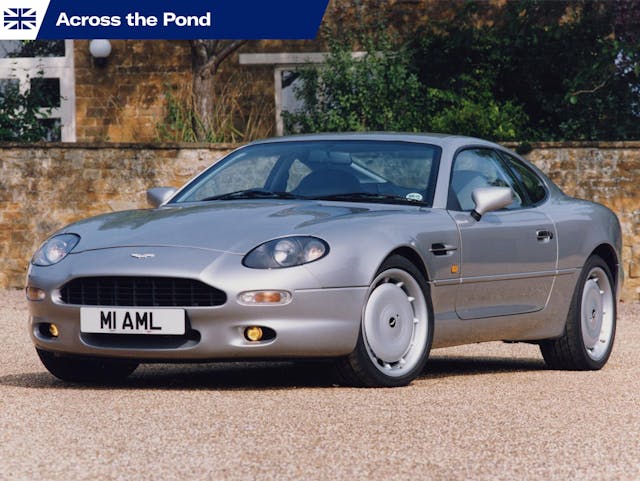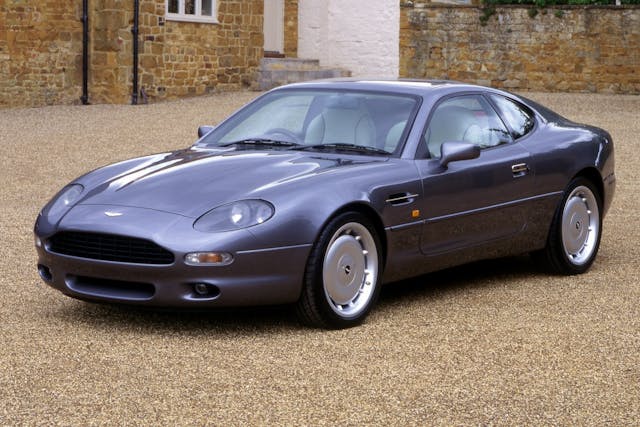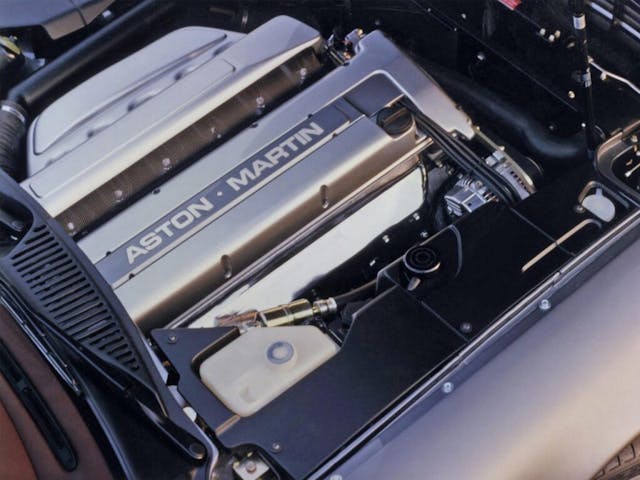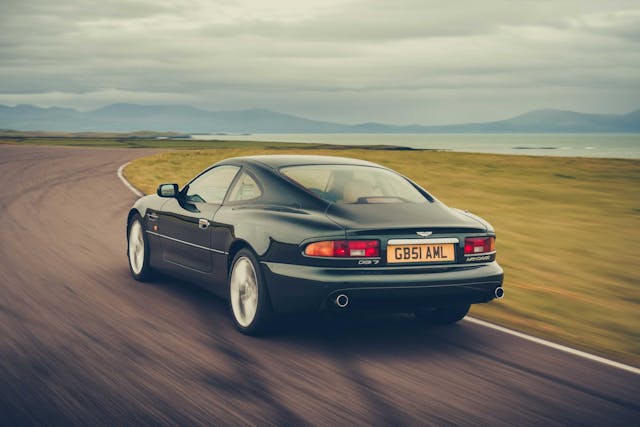Media | Articles
Despite 30 years of trying, Aston Martin design can’t eclipse the DB7

The transition from 2023 to 2024 seems a fine time to celebrate 30 years of the Aston Martin DB7, which made its first public appearance at the 1993 Geneva Motor Show and then went on sale in the autumn of 1994. James Mills went along for the ride all those years ago during his time with the U.K.’s Auto Express; here he shares fond recollections of this monumental Aston Martin. –Ed.
Three decades is a long time, and yet it feels like only yesterday that Ford gave Aston Martin the nod to take the brave but badly needed step from being a quaint manufacturer of hand-made specials to something resembling a 20th century car company.
Before the DB7 made its debut at the 1993 Geneva show, Aston Martin was still something of a cottage builder. You’d have had a slow day counting the cars being pushed to the end of the assembly line at the modest factory in Newport Pagnell, on the outskirts of Milton Keynes.
To understand why that was, you have to go right back to 1958, when production of the DB4 began. That car’s chassis, designed by Aston engineer Harold Beach, would ultimately evolve to accommodate the DB5, DB6, DBS, AMV8, Lagonda, and V8 family. And despite spanning four decades, these cars were all brought to life in much the same, hand-built way, with small crowds of men and women fabricating chassis, assembling engines, beating panels, trimming leather, and sanding down painted bodies between coats. (Presumably with plenty of builder’s brew and biscuit breaks throughout the day.)

Despite the years of practice, it took the Ford-owned company (Ford bought 75 percent of Aston in 1987) about 12 weeks to build each example of the V8 in the ‘90s. The approach held some appeal for the small number of wealthy customers who cared about such things, but it held no appeal to management at Ford, which believed Aston was unviable unless it made more cars.
Marketplace
Buy and sell classics with confidence
So when we rocked up at Aston Martin’s new Wykham Mill assembly plant, near Bloxham—TWR’s former production hub for the Jaguar XJ220 supercar—in October 1994, to collect and drive one of the very first DB7s off the production line, we were witnessing so much more than the arrival of a new car. The DB7 wasn’t just a new, more affordable Aston Martin; it represented a transformation in the way the company built cars and the volume aspirations for the brand and its American owner.
It would be fair to say that I and my fellow motoring hacks writing at the time for weekly rag Auto Express were filled with hope for the future of Aston Martin, because the DB7 promised so much—on paper, at least. We had seen the crowds swarm around it the year before, at the Geneva show, and we appreciated the effect the Ian Callum-designed body had on the pulse rate of car enthusiasts. Further, we knew the tantalising technical ingredients of the front-engined, rear-driven, 335-hp supercharged sports car.

But we also knew that Aston Martin needed more than beauty and brawn to lure drivers out of a BMW 8 Series or a Porsche 911. And in this respect, we had reservations. A seat back release lever fell off as we tried the back seats for size, and you certainly didn’t want to spend any more time than you had to in the two chairs, which, as in a 911, were really only for holding a Hermès handbag rather than taking friends to dinner in Mayfair. And then there was the predictable criticism: the Ford-sourced switchgear. Nobody could blame Aston for using what it had at its disposal and saving a fortune in development and tooling, but the opinion among us was that at this end of the market, Aston could have done more to disguise such origins.
The engineers did a better job of hiding the origins of the Jaguar-sourced, 24-valve, all-aluminum straight-six engine. The decision to adopt a supercharger was faithful to Aston’s heritage but flew in the face of experiments that Jaguar had made in using twin-turbo technology during the development of the so-called F-Type—the troubled replacement for the XJS that ended up being canceled by Ford.

The immediacy of the power delivery and distinctive whine of the supercharger gave the DB7 a character all its own, which was pleasing. This was and still is a part of the car market where you have to find your voice, and Aston had unquestionably come up with something different and, importantly, appealing. It had the brawn of Aston Martins before it but combined this subtly thuggish charm with the sort of polished road manners—a pliant ride and good body control—that meant you would happily consider cruising by DB7 from London to a bolthole in the Scottish Highlands.
What we couldn’t fail to notice and criticize, however, was the driveline shunt, weighty clutch, and heavy (Getrag) gear shift. Some care was called for to drive around this trait in stop-start traffic, or when building and shedding speed on a winding road, although three quarters of the customer base leaned toward the four-speed ZF automatic gearbox. (A supercharged, manual-controlled inline-six would be a relatively rare and special thing to have tucked behind garage doors.) It was also something of an omission that front airbags weren’t made ready for the time of the car’s launch to customers.
Yet when all was said and done, we were impressed. Little old Aston Martin had produced a car that was not only one of the most heavenly looking creations any of us had seen come to market during our careers, but one that was confident in itself and had a character all its own. Its success doubtless encouraged Ford to buy up Aston in its entirety by 1994 and invest in the evolution of the DB7, creating the DB7 Vantage, which brought still more buyers to the marque.
If you read the 2021 Hagerty UK Bull Market list, you’ll already know that the DB7 was and remains to this day a fine introduction to Aston Martin ownership. There’s something else about it that’s significant, I think: This is the car that determined the way Astons would look for generations to come, and I’m not convinced the DB7 design’s deft touch has ever been bettered.

***
Check out the Hagerty Media homepage so you don’t miss a single story, or better yet, bookmark it. To get our best stories delivered right to your inbox, subscribe to our newsletters.












“I’m not convinced the DB7 design’s deft touch has ever been bettered.”
I don’t see it. This thing hasn’t aged well, especially given the affordable AM’s that have come after (the V8 Vantage with its 6MT comes to mind) and the fact that this is too much like a Jaguar XK from the same era. This is the last gasp for Old British-ness, and while that may have charm in some ways, it definitely lacks it in many, arguably more important, others. You can get a V8 Vantage with a 6MT for similar money, or an X150 XKR for less. Aside from some very subjective notes of nostalgia, why would one pick this over its successors?
I think the DB7 is a very pretty car. I do think the original Vanquish and the VH-generation cars — DB9, V8/V12 Vantage and DBS — are even prettier and are aging better (or not at all). IMO, it would be exceedingly difficult to get a decent V8 Vantage, especially with a manual ‘box, for similar money to a 6-cylinder DB7.
Aston has had too many owners and people with different ideas. It has left a mess of cars that just never were what they could have been.
The lack of money at time hurt too.
The resale on many of their new cars shows the lack of interest.
Aston has certainly had a turbulent existence over its 110 years. But it has “left a mess” of cars? Seriously??? Aston as made some not-so-great cars over the years. All manufacturers have. Aston has also made many genuinely great cars, as well as a considerable portion of the most beautiful cars ever built. To name a few, the DB4, DB5, original V8 Vantage, the Vanquish and many of the VH-generation cars were superb. Not bad for a “mess.”
About resale value, Astons are British, and British cars almost never have good resale values. Many people are interested, but don’t know enough about Astons or have been mislead by rumors of massive running costs and unreliability — much of which is inaccurate. That said, it’s primarily Porsches and Ferraris that have vastly higher resale values. Aston resale value does just fine compared to most other cars.
I think it easily got bettered in that cars that immediately came out after the DB7. Now current Aston looks good but does not have the same personality. They are currently having an identity crisis.
Your comment is awaiting moderation. – #1 today
Sorry, but I don’t see this as “one of the most heavenly looking creations…”
It’s downright dowdy compared to its finely-sculpted predecessors.
This looks like a blend of Mazda Miata, Porsche 928 and even Camaro; without the more distinctive stylings of any of them.
It is good, though, that they’ve got a model that’s more “accessible”.